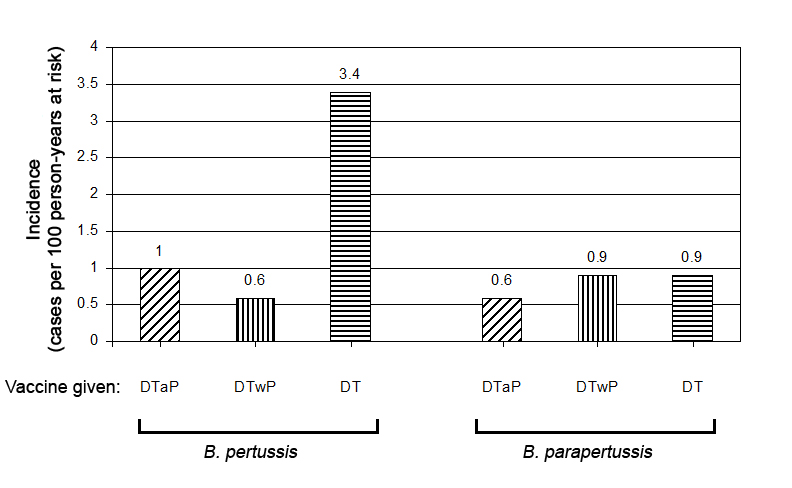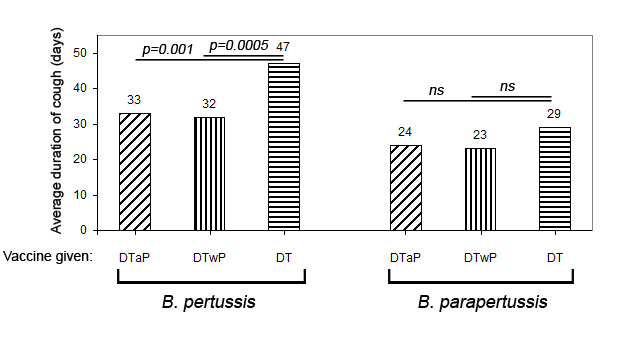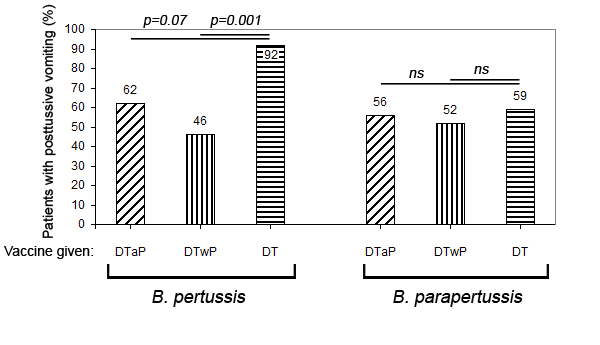The Bordetella species of bacteria Bordetella pertussis and Bordetella parapertussis cause whooping cough in humans. B. pertussis – the bigger cousin – produces more severe symptoms more frequently, and for longer. In fact, while pertussis infection has an estimated 1/125 fatality rate in infants under 6 months, deaths due to parapertussis are almost unheard of, with one report from the 1940s describing the deaths of a 3 and 13-month old girl to parapertussis pneumonia being about the extent of recorded parapertussis deaths in the otherwise healthy.
I previously discussed a study in mice to which people were incorrectly attributing the factoid that the pertussis vaccine increases susceptibility to parapertussis infection. The data showed that in mice previously immunised with an acellular pertussis vaccine (aP vaccine) it took longer to clear a parapertussis infection. As the authors note, the results cannot be simply extrapolated to humans. I found this unsatisfying, as it’s possible a longer infection could lead to a longer duration of disease, or possibly worse symptoms – surely there’s some human data on parapertussis infections in aP vaccine recipients out there?
As it turns out, there is. In the 1990s three big, randomised, prospective aP vaccine efficacy trials were performed, in Germany, Italy and Sweden – the biggest of their kind. As one might imagine, related bacteria that cause similar disease could skew the results when the vaccine is intended to protect against one of the two. As such, in all three trials, a PCR assay that detects specific parts of the genome of each bacterium was used to distinguish between pertussis and parapertussis, along with bacterial culture. Even though the trials were not specifically designed to detect B. parapertussis infection, by recognising the need to discriminate between these two species, they ultimately did. As such, we have data on the incidence and severity of coughing disease caused by each of these species, and how it differs depending on aP immunisation and Bordetella species present.
So: Are acellular pertussis vaccine recipients more susceptible to parapertussis infection?
Here I’ll be presenting graphically the relevant data from each of the trials, where available. Note that the incidence of disease is given in ‘cases per person-year’. In large trials with thousands of subjects, subjects are often enrolled at different time points, and end up being monitored for different periods of time. In order to control for this, the number of cases of disease is divided by the cumulative length of time each group was monitored for. The intention of this is to control for such differences (as simply dividing number of cases by number of subjects would not) and hopefully approximate the true incidence of disease per time at risk.
First is the German trial. This data is taken from Table 1 of A comparative efficacy trial in Germany in infants who received either the Lederle/Takeda acellular pertussis component DTP (DTaP) vaccine, the Lederle whole-cell component DTP vaccine, or DT vaccine

Incidence of B. pertussis and B. parapertussis in German study population, by vaccine group and species infecting. DTaP – diphtheria-tetanus-acellular pertussis vaccine; DTwP – diphtheria-tetanus-whole-cell pertussis vaccine; DT – diphtheria-tetanus vaccine.
As you can see, while there is a large and statistically significant difference in pertussis incidence (left) between vaccine groups (equating to 72% and 83% vaccine efficacy for aP and wP vaccines, respectively) there is barely any difference between the groups when it comes to the frequency of parapertussis infections (right), and the little difference there is isn’t statistically significant. So the German data paints a picture of the aP vaccine decreasing susceptibility to contracting pertussis, but not affecting susceptibility to parapertussis infection.
Next is the Italian data. The pertussis-specific data is taken from A controlled trial of two acellular vaccines and one whole-cell vaccine against pertussis. Progetto Pertosse Working Group. The parapertussis-specific data is taken from a follow-up paper by the same authors, in which they analysed the parapertussis data from the same trial, Bordetella parapertussis infection in children: epidemiology, clinical symptoms, and molecular characteristics of isolates

Incidence of B. pertussis and B. parapertussis in Italian study population, by vaccine group. DTaP SB – Smithkline-Beecham DTaP vaccine; DTaP C – Connaught Laboratories DTaP vaccine.
Again, all of the pertussis-immunised groups show a statistically significant difference in pertussis incidence when compared to the control group. However, there are no statistically significant differences in the rate of parapertussis between vaccine groups.
“Now hang on” you might say, “the difference in pertussis incidence between the DTwP and DT groups is about 1.2 cases/100py, and that’s statistically significant, so how is it that the 1.3 cases/100py differnce in parapertussis incidence between the DTaP SK and DT groups isn’t significant?”
Good question. So the calculation for statistical significance isn’t just based on the relative differences between the groups, it’s also based on the strength of the data. This can be factored in in a few ways, such as taking the length of surveillance or number of cases into account (for example, one result based on comparing three cases to three cases may not reach statistical significance, but calculating the same frequency after comparing hundreds to hundreds may). In this case, the pertussis data is based on a total of 288 cases, while the parapertussis is based on a total of 76 cases. I hope that answers your question.
As for the Swedish trial, the collected parapertussis data is not discussed in the study. As with the Italian data, it was discussed in a follow-up paper. However, in this paper they seem more interested in discussing the data they collected on two non-Bordetella organisms that can cause whooping cough. They don’t discuss parapertussis that much, but do say:
B. parapertussis infections fulfilling the clinical WHO criteria
for pertussis were evenly distributed between the vaccine
arms.
I did try to extract data to present graphically as above, but the lack of focus of parapertussis in this article made specifics unclear and my attempt impossible.
So, did the biggest prospective trials of aP vaccination performed in human history find any evidence that susceptibility to B. parapertussis is influenced by receipt of an aP vaccine?
No.
Okay.
Well, I did mention another theoretical outcome of impaired bacterial clearance: worse/longer lasting symptoms.
So: Are acellular pertussis vaccine recipients more susceptible to longer/more serious parapertussis infections?
While the other two studies were not as helpful, the German study authors were thoughtful enough to include the breakdown of their pertussis data , with regard to severity of infection.

Average duration of coughing illness by vaccine group and pertussis vs. parapertussis infection. Abbreviations are as explained above. Source
As you can see, there is a statistically significant influence from aP immunisation on the duration of coughing illness caused by B. pertussis. This is consistent with later research showing aP immunisation alleviates disease in cases of pertussis in the immunised. Looking to parapertussis cases we see there is no significant difference in duration of symptoms between the control and pertussis vaccine groups.
What about severity of disease? One way to measure that is to look at the proportion of patients that have more severe symptoms on infection.

The percentage of patients to experience posttussive vomiting, by vaccine group and causative organism. Source
Posttussive vomiting refers to the act of throwing up following a coughing fit. As you can tell from the ‘DT’ pertussis case data in the above figure, this is common in the unimmunised who catch pertussis, but can be alleviated by immunisation. As for parapertussis cases, there was no statistically significant difference in the proportion of patients to experience posttussive vomiting, regardless of which vaccine group they were randomised to.
Unfortunately, the Italian group did not analyse their parapertussis data by vaccine group. However, they did explore the duration of various symptoms, and how aP immunisation alleviated those caused by B. pertussis. Click here to see the summary. This figure gives a pretty good idea of just how bad pertussis disease can be, and shows how the severity of symptoms is reduced in the vaccinated that do catch the disease.
So, did the largest available prospective aP vaccine trials uncover any evidence to support the hypothesis that the whooping cough shot increases length/severity of symptoms of either kind of whooping cough?
No.
So while it is not ethically possible to test whether the phenomenon (of impaired clearance of parapertussis in the aP immunised) observed in mice also occurs in humans, we can conclude that none of the potential negative manifestations thereof can be seen in human recipients of the aP vaccine in the biggest prospective trials to date.
So never fear – immunising yourself of your child against whooping cough will not raise the chances of catching either cause of whooping cough.

Pingback: Whooping cough vaccination, pertussis and parapertussis: forty times more likely to be misunderstood? | The LymphoSite
Pingback: Anti-vaccine chiropractors 8 | reasonablehank
Pingback: Anti-vaccine chiropractors 36 | reasonablehank
Thank you for this post- Using it to clarify some online misconception.
Pingback: Whooping cough bacterium loses expression of a key vaccine target | The LymphoSite